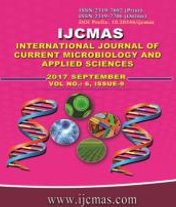


 National Academy of Agricultural Sciences (NAAS)
National Academy of Agricultural Sciences (NAAS)

|
PRINT ISSN : 2319-7692
Online ISSN : 2319-7706 Issues : 12 per year Publisher : Excellent Publishers Email : editorijcmas@gmail.com / submit@ijcmas.com Editor-in-chief: Dr.M.Prakash Index Copernicus ICV 2018: 95.39 NAAS RATING 2020: 5.38 |
Foot Infection is a chief complication of diabetes mellitus leading to complications like gangrene and limb amputation and constitutes common diabetes-related cause of hospitalization. This study was undertaken to characterize the aerobic bacterial isolates from diabetic foot infections and analyze their antibiotic resistance pattern in a tertiary care hospital of north Kerala. A retrospective study was carried out on samples of exudates from129 patients with diabetic foot infections over one year period from January through December 2016. Data Analysis was done using WHO NET ANTIBIOTIC RESISTANCE SURVILLENCE SOFTWARE; data was entered in Excel and analyzed using EPI INFO 2013 software. Out of 129 samples studied, 100(77.5%) showed growth of organisms.The most vulnerable age group was 51-60 years where the incidence was 39%. Of these 100 culture positive samples, 66 were monomicrobial and 34 polymicrobial. In all a total of 139pathogens were isolated; Staphylococcus aureus and Pseudomonas aeruginosa were the predominant isolates. All strains of S. aureus were sensitive to vancomycin and linezolid. Pseudomonas aeruginosa exhibited least resistance to imipenem and meropenem. It is mandatory to characterize the causative agents, determine antibiotic susceptibility and initiate appropriate antibiotic therapy to ensure successful outcome of diabetic foot infections.
 |
 |
 |
 |
 |